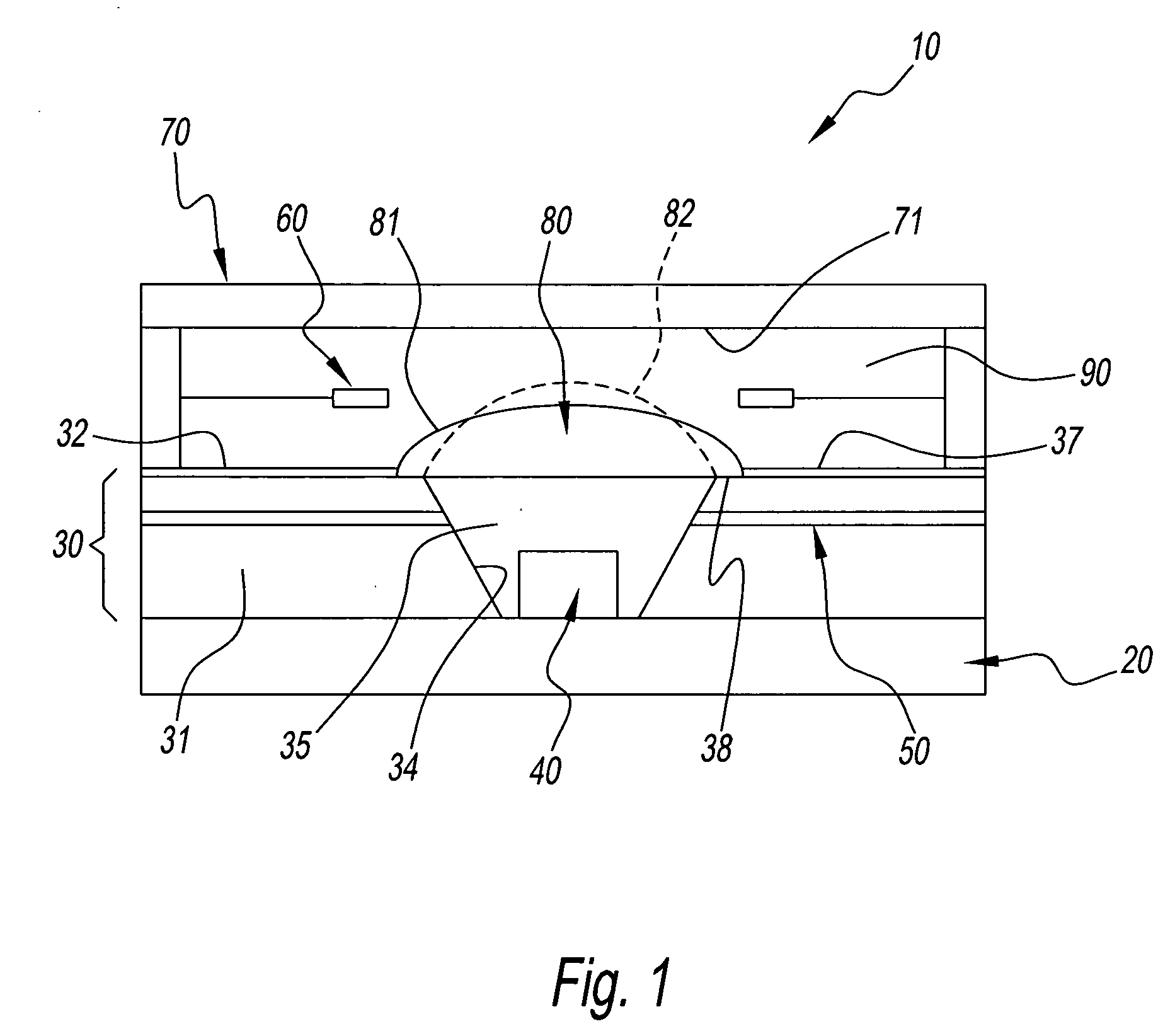Light-emitting device and method of making same
- Summary
- Abstract
- Description
- Claims
- Application Information
AI Technical Summary
Benefits of technology
Problems solved by technology
Method used
Image
Examples
second embodiment
[0046] A light-emitting device 110 in FIG. 3, which is the second embodiment, has the same primary structural parts as light-emitting device 10 in FIG. 1. The structural parts shown by numbers wherein 100 is added to the reference number in FIG. 1 have the same effect as the structural part shown in FIG. 1. What should be noted with respect to light-emitting device 110 in FIG. 3 is that the dimensions of the opening of open part 134 are relatively large. As a result, light-emitting device 110 is structurally characterized in that, in addition to almost the entire top surface of bottom container 30, there is a hydrophilic part 137 at the area around the outside of the top surface of resin 135, and electrode 150 comprises a horizontal part 151 extending horizontally and an inclined part 152 extending along the inside surface of open part 134.
[0047] It is also possible to make a transparent lid-like member of a pre-determined thickness that engages with the top end of open part 134 as ...
third embodiment
[0048] A light-emitting device 210 in FIG. 4, which is the third embodiment, is a modified version of light-emitting device 10 in FIG. 1 and differs from light-emitting device 10 and light-emitting device 110 in that it does not have the surface modified part that extends horizontally. The structural parts represented by numbers wherein 200 has been added to the reference number in FIG. 1 have the same effect as the structural parts in FIG. 1.
[0049] Resin 235 introduced to the inside of open part 234 does not fill the entire open part 235 in light-emitting device 210. As a result, first liquid 280 is disposed aligned on top of resin 235 with the inclined surface of open part 234, which is inclined such that it extends deeper toward the middle of open part 235. Moreover, related to this, first electrode 250 comprises a horizontal part 251 and an inclined part 252 that extends away from the inside surface of open part 234 and virtually parallel along the inside surface, and second ele...
fourth embodiment
[0050] A light-emitting device 310 in FIG. 5, which is the fourth embodiment, is yet another version of light-emitting device 10 in FIG. 1. First liquid 380 is separated from the layer of resin 335 by second liquid 390 and forms a convex dome that points downward toward light-emitting element 340. The structural parts shown by numbers wherein 300 is added to the reference number in FIG. 1 have the same effect as the structural parts shown in FIG. 1.
[0051] According to FIG. 5, top container 370 comprises hydrophilic part 377 that has been formed by surface treatment or another treatment of all of the inside of the top wall except a center portion. First liquid 380 is usually disposed as shown by the solid line on the inside of this hydrophilic part. The rest of airtight space 371 is filled by second liquid 390. This differs from the embodiments in FIGS. 1 through 3 mainly in that the positions of first and second liquids 380 and 390 are reversed.
[0052] First electrode 350 for contro...
PUM
 Login to View More
Login to View More Abstract
Description
Claims
Application Information
 Login to View More
Login to View More - R&D
- Intellectual Property
- Life Sciences
- Materials
- Tech Scout
- Unparalleled Data Quality
- Higher Quality Content
- 60% Fewer Hallucinations
Browse by: Latest US Patents, China's latest patents, Technical Efficacy Thesaurus, Application Domain, Technology Topic, Popular Technical Reports.
© 2025 PatSnap. All rights reserved.Legal|Privacy policy|Modern Slavery Act Transparency Statement|Sitemap|About US| Contact US: help@patsnap.com



